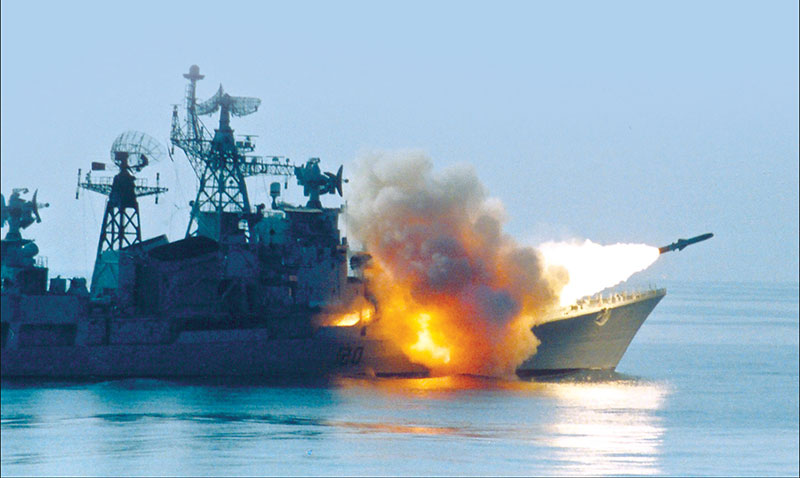Naval variant of BRAHMOS missile has successfully been integrated into the navy’s maritime assets
The ship-launched anti-ship variant of the BRAHMOS missile was first inducted into the Indian Navy in 2005. The naval variant was also the first supersonic cruise-missile to enter service in the Indian armed forces. The naval variant of the BRAHMOS can be launched in single or in a salvo from a ship towards single or different types of targets within an interval of 2-2.5 seconds in various trajectories.

A salvo of eight missiles can penetrate and destroy a group of frigates having modern anti-missile defences. The missile’s Fire Control System, Launcher, and inter-connectivity with ship’s navigation and sensors provide a salvo launch capability, wherein multiple missiles can be fired in different trajectories to hit a single or group of targets. The missile’s mid-course guidance is provided by an Inertial Navigation System and the terminal course guidance by homing radar seeker.
The BRAHMOS anti-ship variant was first configured with the Indian Navy’s frontline destroyer, INS Rajput. While the initial inductions of the missile were installed in the inclined launch configuration, later, in 2008, the BRAHMOS missile was successfully fired from a state-of-the-art Universal Vertical Launch Module aboard INS Ranvir. The UVLM, fully designed and developed by BrahMos Aerospace and L&T, is presently installed in a plethora of frontline warships of the Indian Navy.
The naval version of BRAHMOS is increasingly used in vertical launch mode as opposed to the earlier inclined launcher used on the Rajput class destroyers. This ensures more ready-to-fire missiles and higher rate of fire. The naval variant has undergone several improvements like the inclusion of an indigenous seeker and enhanced range which has been relaxed with the signing of the Missile Technology Control Regime (MTCR).
The land-attack variant of BRAHMOS was first test fired in 2008 from INS Rajput. Since then, the land-attack variant has been successfully tested on INS Teg. The land-attack ship-launched variant has also undergone a number of modifications including tremendous gains in effective engagement range of the missile.
In November 2015, BRAHMOS anti-ship variant was successfully fired from INS Kochi wherein the missile, after performing high-level and extremely complex manoeuvres, successfully hit decommissioned target ship ‘Alleppey’ located at a distance covering nearly the full range of the missile with high precision. The launch from INS Kochi was part of ‘Acceptance Test Firing’ during a naval drill being conducted along the country’s west coast.
Also, in the pipeline are BRAHMOS launchers on the under-construction 17A stealth frigates. The naval variant of BRAHMOS will also be fitted on the Project 1135.6 Admiral Grigorovich-class frigates that the navy will be acquiring soon. Last year in May 2018, L&T officially handed over the prototype Quad Launcher to BrahMos Aerospace. The Quad Launcher is designed for launching BRAHMOS supersonic cruise missiles in an inclined configuration on-board Indian Naval ships. The launcher provides superior firepower as compared to the twin canister, deck mounted launchers and has a capability to support and launch four missiles in a single or salvo mode. The new Quad Launcher is suitable for warships which have space constraints to accommodate a Vertical Launch Module and will be equipped on the Indian Navy’s warships starting this year.
Time and again, the naval variant has proven its mettle. It has not only undergone several rounds of successful testing but has also been successfully integrated into the Indian Navy’s waterborne assets. Future developments of the BRAHMOS naval variant might see further improvements in speed, range, and accuracy as with the other land and air variants.

